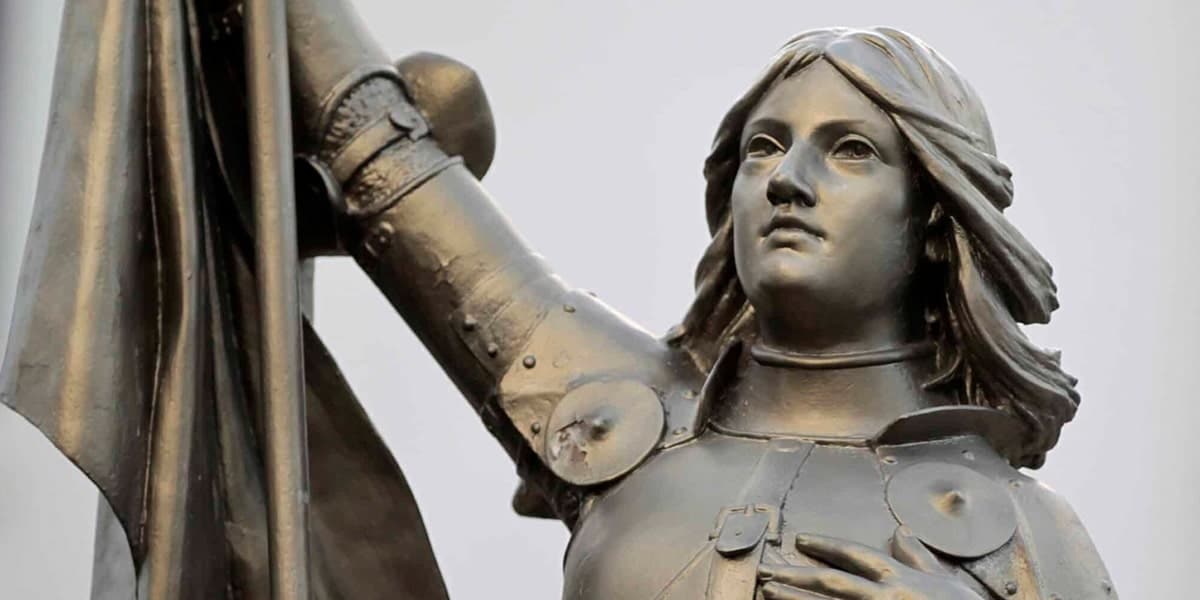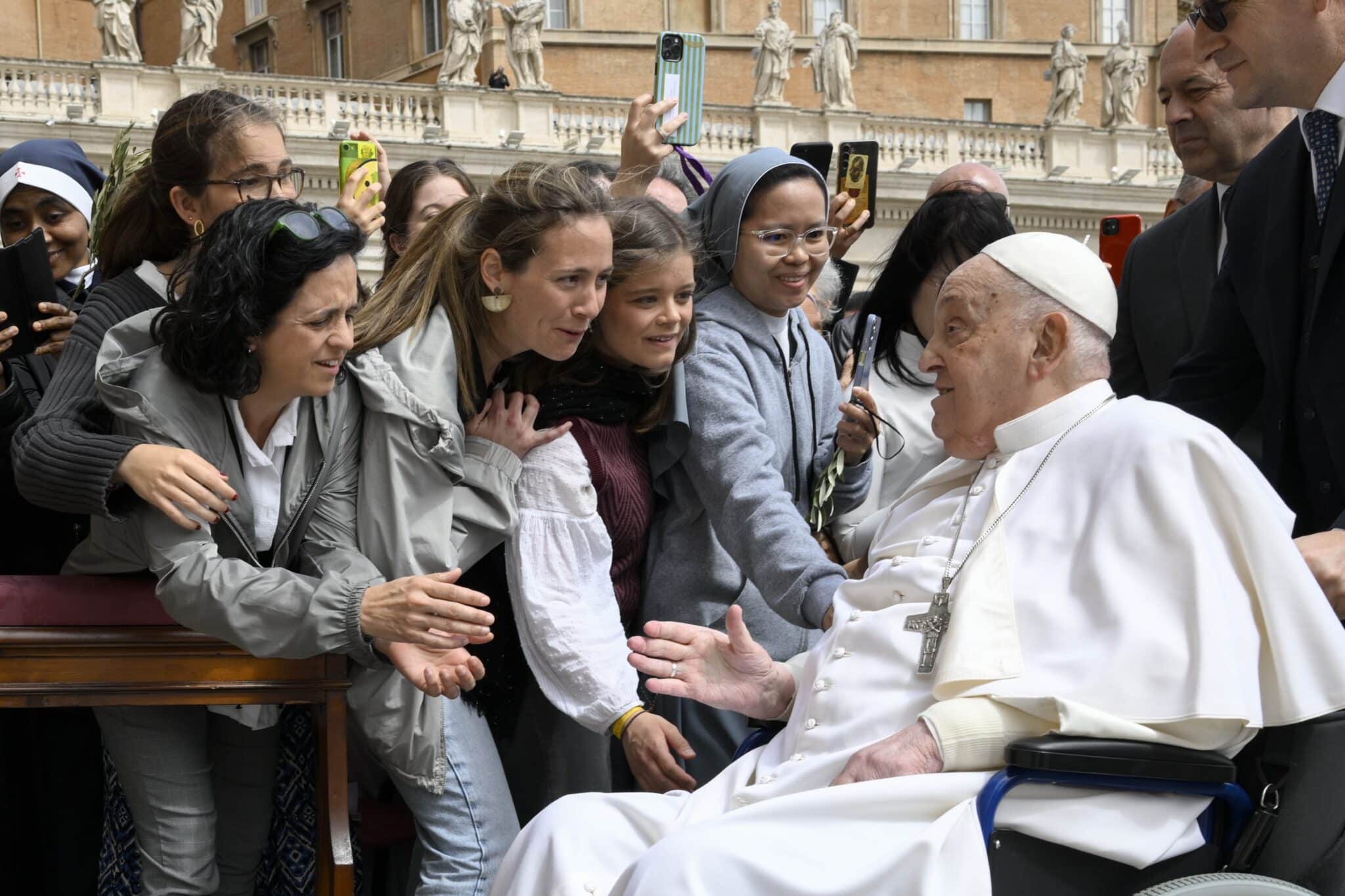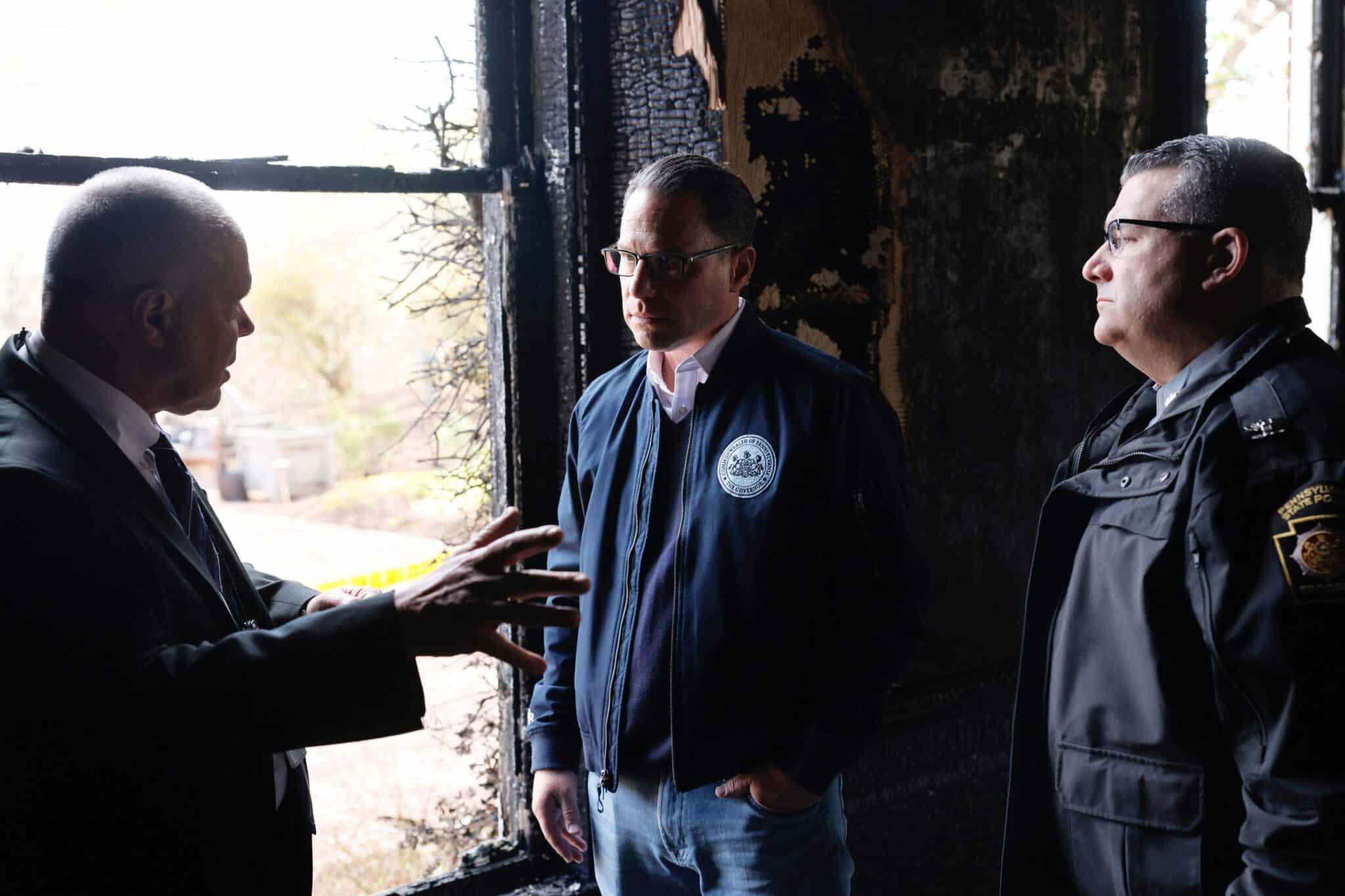Was she inspired? Was she mentally ill? Does her example of armed resistance have anything to say to Americans mired in unrest? What does a 19-year-old who lived in the 15th century have to teach us?
I, who have always considered Joan my patron saint since my middle name is Jean, believe she can teach us how to listen to the mystical voices sent from God to direct us. She inspires us with her courage in stepping out in faith and expands our notions of gender roles. She is an example of how to trust in God when all seems hopeless and how to overcome betrayals—even by friends. She shows us how to battle the Church on issues like, in our time, clergy sexual abuse, and how to maintain our focus on Jesus and the crucifix.
Sainthood Came Slowly
Joan is open to many different interpretations, but actually her life is well-documented.
Régine Pernoud, who was considered the grande dame of French historical writing on the Middle Ages, says in Joan of Arc: Her Story (St. Martin’s Griffin, 1998), “there is scarcely a chronicle or memoir from her time and place that does not mention her.”
Joan left behind public and private letters that she dictated, and even appears on the register of the Parlement of Paris. We have what amounts to transcripts (available on the Internet) of her two trials (one which condemned her when she was alive and one which nullified that first verdict 25 years after her death).
Even though the second trial cleared Joan of heresy, it was not until 1909 that she was beatified. The fact that it took over 450 years for the Church to recognize her as a holy person to be emulated shows the ambiguities in her life (and the embarrassment she was to the Church because its ecclesiastical trial had condemned her). But once her canonization started, it proceeded with remarkable speed.
During the 19th century she had become the romantic soul of France, its national heroine. Many French soldiers during World War I had a particular devotion to her, and France had suffered greatly in the war. Joan was declared a saint in 1920.
A Question of Names
The “mystery” of Joan begins with what to call her. “In my country [the region of Lorraine], people called me Jeannette, but they called me Jeanne when I came into France,” she said at her condemnation trial.
In the 15th century, most people went only by first names but sometimes added a place of origin or residence. She called herself “Jeanne la Pucelle” (Joan the Maid), declaring chastity the sign of the purity of her mission. She had learned to sign her name as Jehannes and wrote it that way on several documents.
Pierre Cauchon, her chief judge, called her “Jehanne whom they call the Maid.” And his colleagues at the University of Paris, who used Latin, referred to her as “mulier quae Johannam se nominabat” (“the woman who called herself Joan”).
“Of Arc” or “Darc” or “Tarc” first appears in her nullification trial when describing her brothers, Pierre and Jean, and mother, Isabelle. (Apostrophes came into use later to connote local origin or membership in the nobility.) In French, arcrefers to a bow. A 1612 account of her life says that “the very arms of the parents and other descendants of the aforesaid Jacques Darc [her father]…carried a bow with three arrows….”
In general today, English speakers refer to her as “Joan” and French speakers call her “Jeanne.”
A Product of War
The Hundred Years’ War of Joan’s time refers to a series of wars between France and England from 1337 to 1453. Overall, it was a “total war,” which involved the whole population. Its aims were not clear. All of it took place on present-day French soil. Both armies got mired down, the battles claimed many lives, thousands were maimed and the war seemed interminable.
The fourth and final phase of the Hundred Years’ War involved Joan. She inspired the deliverance of the city of Orléans from the English and propelled the dauphin (the French claimant to the throne) to Reims for his anointing and coronation. An Anglo-Burgundian alliance engineered Joan’s death at Rouen in 1431 but could not undo the French military recovery she initiated. By 1453 the English were nearly completely expelled from French soil.
Though mercifully not 100 years long, the Vietnam War of the 1960s and 1970s and the current Afghanistan and Iraq wars should give Americans some sympathy for what the French of the 14th and 15th centuries endured. But neither of these was conducted on American soil. To get some sense of the devastating, demoralizing effect of this French war, the American Civil War is a better comparison.
A Church Recovering from Schism
Joan was also a victim of the Great Schism in the Church, when two popes claimed control, one in Rome, one in Avignon, a papal city on the Rhône River directly across from southern France. In addition, from 1409 to 1415 there was even a third claimant!
The University of Paris faculty favored conciliar reform, and supported the Plantagenet (English) claim to the French crown. The professors hoped a dual monarch of both France and England would have his hands so full that he would rely more on the parliamentary institutions of both countries. It was their hope for more democratic government that spawned their furious opposition to Joan, whom they saw as representing a return to absolutism, royal and papal. Many of the Paris theologians were among Joan’s challengers at her trial.
When Joan tried to appeal to the pope, one of the trick questions her opponents asked her was to which pope she was appealing. And they never forwarded her appeal to anyone.
Today, we too see a Church in turmoil, still dealing with the reaction to the Second Vatican Council. We’ve seen five popes in the last 50 years. And the U.S. Church is struggling in the aftermath of the clergy sex-abuse scandals to regain its credibility and solid financial footing.
Joan would understand such tensions, but despite the flawed bishops and theologians she encountered, she never wavered in her faith in the Church of Jesus Christ. She is a dutiful daughter of the Church Militant, a term she had to have explained to her at her trial. She never gave up on the Church, even as she experienced its persecution.

A Life Cut Short, Told Briefly
The youngest of five children, Joan was born on January 6, 1412, in Domrémy-Greux, which is along the winding Meuse River, southeast of Paris. Her father, Jacques, was a farmer, fairly well-to-do for a peasant. In 1423, Jacques was chosen doyen for the village, which meant he commanded the day and night watches, supervised the weights and measures, collected taxes and rents, and promulgated the decrees of the village council.
Joan was only 12 when she experienced the first of her visions, which she described as a voice or voices accompanied by blazing light. Later, she came to identify the voices as those of Saints Michael the Archangel, Catherine and Margaret. St. Michael, usually depicted with a flaming sword, is the angel who drove the angel Lucifer out of heaven; Saint Catherine of Alexandria was the patron of young girls and her statue was at a parish near Joan; Saint Margaret of Antioch’s statue was in Joan’s home parish in Domrémy. (The latter two saints have made way for others in the Church’s worldwide liturgical calendar.)
Joan claimed the three revealed to her that she had a mission to save France.
One of Joan’s prophecies came true when the French were defeated at the 1429 Battle of Herrings (related to a shipment of herrings for the besieged city of Orléans). This gained her the support of Robert de Baudricourt, the French commander at Vaucouleurs, who sent her on to the dauphin, as she requested.
That dissolute young man was at the palace at Chinon, along the Loire River. According to legend, he disguised himself to test if Joan could recognize him, which she did. (Today this scene is staged with life-sized mannequins at Chinon.) He became convinced of her mission and put her in charge of an expedition to relieve the besieged Orléans, after having her examined by theologians at Poitiers to ensure she was not in heresy.
At Orléans she led her forces to victory. (Copies of the banners carried by her forces are still in the cathedral there.) Then she followed this with a victory over the British at Troyes, where she captured the city. Finally, on July 17, 1429, she was next to Charles when he was crowned King Charles VII at Reims.
Joan failed in an attempt to capture Paris in August 1429, and was captured in May 1430 near Compiègne. She was held in a tower in Beaurevoir for months, and on November 21 of that year was sold to the British by John of Luxemburg. She was then moved to Rouen.
She was charged with “lack of submission to the Church Militant” and with the wearing of men’s clothes. Her accusers were convinced that her visions came not from God but from the devil and that she practiced witchcraft.
The judge (Bishop Pierre Cauchon of Beauvais), theologians with whom he had taught at the University of Paris, assessors and others tried many ways to trip her up, but she withstood four months of their constant questioning. Under intense political pressure from the British and because Joan went back to wearing men’s clothes (perhaps after a rape attempt in prison), Cauchon condemned her to death. In the end, wearing men’s clothes was the only charge that held up, which was considered a deliberate relapse into error, a visible sign of her refusal to submit to the Church.
On May 30, 1431, Joan was led from prison to the Old Marketplace in Rouen and burned at the stake there. She asked to hold a cross and died crying out the name of Jesus. Her ashes were collected and scattered in the Seine River, so that no relics could later be claimed.
Models a Faith Journey
Joan of Arc is like a shooting star across the landscape of French and English history, amid the stories of the Church’s saints and into our consciousness. Women identify with her, men admire her courage.
She challenges us in fundamental ways. Despite the fact that more than 500 years have passed since she lived, her issues of mysticism, calling, identity, trust and betrayal, conflict and focus are our issues still.
Joan began with peculiar, intimate communication from and with God, and was moved to work for justice on earth, as theologian George H. Tavard points out in The Spiritual Way of St. Jeanne d’Arc (Liturgical Press). “Her life offers a perfect example of the conjunction of contemplation and action,” he writes, because her spiritual insight is that there should be a “unity of heaven and earth.”
Moreover, she was the essential activist, literally stepping out in faith, with no idea where she would end up. She did not let her youth stop her. She knew only that she had to do “something” to save France, and took her compass from the God she heard within herself.
Joan persevered in her faith, accepting her many crosses for the sake of the Cross. She remained steadfast in her mission, having fulfilled Saint Paul’s admonition to “Fight the good fight of the faith” (1 Timothy 6:12).
James Martin, S.J., associate editor of America, attributes his lifelong fascination with Joan to the “marvelous illogic of her story.” She was the first saint he really “met,” he says. “And like my introduction to French in high school, Joan’s story also introduced me to a new language: the special language of saints, made up of verbs like believe, pray, witness and the nouns of their actions, humility, charity, ardor.”
Martin continues: “Yet Joan confuses me as much as she attracts me. She acts like a crazy young girl, hearing voices, leaving her family, going to war and dying for an unseen person. Her story is more profoundly other than those of almost any other saint….Even Saint Francis of Assisi would seem more at home in our world than Joan.”
Joan helped him to discover his vocation as a Jesuit, Martin admits. “Joan found her way to God by learning a language that no one else could hear, and so is the perfect model for someone on the beginning of a faith journey. She has no idea what path to take to reach her destination, and neither did I.”
Joan speaks most strongly to today’s feminists because, in an age when women were silent, she spoke up. She allowed no man to relegate her to the background when she was convinced that God was directing her. Joan often sought and received help from other women, becoming a pioneer of “networking.”
She’s also an inspiration to those working for reform of the Church in the wake of the sex-abuse scandals. The Voice of the Faithful, which has already taken heart from Catherine of Siena’s daring scolding of a pope, could take Joan as another model. But they probably don’t want to wait 500 years for vindication as she did.
One of Joan of Arc’s “daughters,” Joan Chittister, O.S.B., a social activist and well-known author, includes the following prayer to Joan among the 22 litanies of saints and holy people in her book, Prayer for Conscience and Courage in Times of Public Struggle (Benetvision, 2007):
“Saint Joan of Arc,
you were burned at the stake
as a heretic by the Church itself
for refusing to betray
the voice of God in you.
Touch our conscience
on behalf of the visionaries
in Church and society
and give us the courage
to share the risk.”
What began by Joan of Arc listening to her mystical “voices” and to her heart eventually freed a people. She dared to defy the prescribed gender roles of her day. Her trust in God gave her courage. Her perseverance allowed her to overcome betrayal by friends and keep her wits at her trial. Through it all, especially at her death, she kept her focus on Jesus and his crucifix. Joan’s faith journey awes us still.








